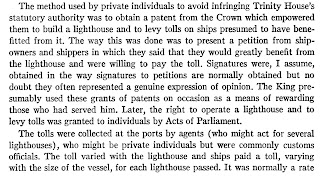Earlier this week Daniel Shestakov noted the publication of
a new paper
on lighthouses by Erik Lindberg. He and I then had a brief exchange on
twitter about whether or not the work since Coase’s
(1974) paper had supported or contradicted his contentions. It got me
thinking that maybe I had missed something in the more recent work. I went back
and looked at some of the papers. I’m still not entirely certain what Shestakov’s
position is, but it seemed to me that he was claiming that recent work had
supported the theorists rather than Coase. I still don’t see it that way. Theory suggests that if a good is non-rival
and non-excludable that there will be a free rider problem and that the outcome
will be inefficient in the sense that it will not maximize the sum of consumer
and producer surplus. Coase did not set
out to refute the theory. He simply argued that it did not necessarily apply in
the case of a commonly used example: the lighthouse. The extent to which a good
is non -rival and non-excludable is an empirical question. Coase argued that in
some cases lighthouses were not in fact non-excludable. In some cases it is not
prohibitively costly to charge the users for the service. It seems to me that
recent work has not refuted this claim.
My interpretation of Coase’s paper is that it was really
much more about economic methods than it was about lighthouses or public goods.
The paper was about the way that economists like Samuelson didn’t bother to
study the history of lighthouses before using them as an example of a public
good. The primary claim of the paper was that the theory of public goods did
not necessarily apply to lighthouses because in some cases it was possible to
make the people who used the lighthouse pay for the service provided.
Specifically, it was possible to identify which lighthouses a ship had
benefited from and charge them accordingly at the time they docked. Coase
described the finance and operation of private lighthouses as follows:
It was, for instance, much like a private toll bridge.
Coase may actually overstate the extent to which the government set price
distinguished the case of lighthouses from most goods. He was clearly aware of
the extensive role of government in the provision of lighthouses, and he made
no effort to hide this from his readers. Coase, however, characterized the
government’s involvement as being not substantially different than the
provision of other goods by private companies:
Responses to Coase’s paper seem to fall into two categories.
1.
Government was extensively involved in the so
called private lighthouses. Therefore, the lighthouses were not as private as
Coase suggested. It has even suggested that it is ironic that Coase chided
other economists for not getting their facts straight and then failed to do so
himself.
2.
Coase’s speculation about the relative
efficiency of private provision is unsupported by the evidence.
Van
Zandt (1993) falls into the first category. Van Zandt, however, does not
seem to disagree with Coase’s description of the finance and operation of
lighthouses. Instead, he disagrees with the interpretation. His primary argument
is that the “public” versus “private” dichotomy is not very useful. Coase seems
to have agreed with Van Zandt in so far as Van Zandt notes that Coase suggested
that there may be an even wider variety of institutional arrangements than he
considers.
Bertrand (2006)
agrees with Van Zandt that there was extensive involvement of the government in
the so-called private lighthouses. She claims at one point that “We have thus
shown that Coase, in his account of the English lighthouse system,
underestimates the importance of government, and conversely overestimates the
appropriateness of individual initiative (Bertrand 400).” But like Van Zandt
she has not actually shown that the lighthouses were financed and operated differently
than Coase described. People obtained charters from the government, which set
the fees and was sometimes directly involved in the collection of these fees. But
Coase said all of that. He never suggested that the government was not at
involved. He never even suggested that it was not extensively involved.
Bertrand also argues that Coase overestimated the efficiency
of the private lighthouses. The problem here is that Coase’s argument wasn’t about
the relative efficiency of the private versus public provision. He did little
more than speculate about them in the conclusion of the paper, and suggest that
more research needed to be done.
Finally, Lindberg (2015) adds a comparative perspective as
well as details about the amount of fees collected. Perhaps, most importantly,
I think he moves in the direction originally suggested by Coase. He analyzes
the actual lighthouse systems that existed in different places and times to try
to understand what might explain the differences in institutional arrangements.


No comments:
Post a Comment